

AMERICA:
American
Patriotism is grounded in the desire to be
Free.
"TO
THE
SHORES
OF
TRIPOLI" The role of AMERICA
[as NEW BYZANTIUM] in defense of the Western World against the
lawless factions of the Islamic World dates back to 1784 under the
leadership, continuous initiatives, and foresight of Thomas Jefferson. Not
only by diplomatic means but also through the bravery of the American
military and naval action did the scourge of piracy and extortion at last
come under control. The same as today, not all European countries
contributed enthusiastically if at all to the effort and sacrifice needed.
Therefore, the leadership and actual application of decisive force fell on
American hands: the same as it does today. The difference in geographical
scale is the only distinguishing element between America-New Byzantium and original
Byzantium as protectors. Otherwise, the task remains identical.
For example, an article written by Christopher Hitchens titled To The
Shores of Tripoli is posted on the Internet by TIME.
Within days of his March 1801 inauguration as the
President of the United Sates, Thomas Jefferson ordered a
naval
[Ref: http://www.com/time/magazine/article/0,9171,994562,00.html]
___________
Byzantium-New
Rome or Byzantine Empire today is but an ornament on the
genealogical tree of history that cannot
The struggle is against
terrorism in all its aspects: whether spontaneous, self-organized,
or state-sponsored.
Religious
Conviction Abhors Terrorism: It Condones Justice.
It is folly
and misleading to reason that the Moslem invasion of Central Europe was the consequence
of Moslem penetration of the Iberian Peninsula and of the Balkans. Both
these events were only symptomatic of a much more fundamental occurrence earlier
in history: the ill-conceived and treasonous invasion and devastation by the
West itself of Constantinople at the opening of the Thirteenth Century.
It is also unfounded to reason that in some way Islam today holds the higher
moral ground over Christianity because the women of the West have achieved a
more independent and stronger contributory status in society. Why then are
Moslem women clamoring for even their basic freedom? The true issue in
that quest is not the presence of that freedom but how that freedom is used.
Since its founding, New Rome, or Constantinople, or Byzantium had always been
the guardian and protector of the West. It was the rupture of that Western
integrity that opened the way for the later Moslem onslaught against Europe.
The Western world committed a grave error once. Today, the same
confrontation exists but on a much larger scale, including the interests of
progressive Islamic nations. In this instance, America has become the
defender of Civilization and thus, New Byzantium. The error must not be
repeated. The unity and firm coalition of Western nations together with
that of the progressive nations of the world is paramount for the survival of
all Civilization.
"Former Archbishop Iakovos of North and South America [Greek Orthodox
Church] called the terrorist attack a 'demonic act' . . . . He went on to say ,
. . . there is organized violence that goes back many centuries since the
Persian Wars when the Anatolian people were trying to destroy Christendom and
the 'white' race."
The above was published in "Revista
Cayey" of
Act of the Roman Senate (16-V-1525, Lib. Decr. 1515/1526, f. 142)
Link to: ____________________________________________________________________________________________________
QUINTO CENTENARIO
FIFTH CENTENARY Reference:
Lascaris-Comneno, Teodoro.
(1993). Quinto Centenario: Encuentros y Desencuentros al Medio Milenio de
Hallazgo del Nuevo Mundo [Fifth centenary: Encounters and divergencies on
the half millennium of discovery of the New World].
(Pp.136-139). Consejo
Nacional de la Cultura (CONAC). Caracas, Venezuela: Colper, Editores. (Original
in Spanish).
(Closing Chapter - translation)
The
[said]
New Era is rendered by the internal process that is produced in each individual
and globally in the whole community. It is an ample and tolerant form of
thinking, whereby man is neither come to suffer nor to pay for a bad deed, but
to live in harmony in the midst of all and by way of our means. When
harmony is broken, emotional and physical disturbances arise that range from
sadness to grave illnesses.
Within the New Era, eastern philosophical views and high level psychic
manifestations will have preeminence, with absolute respect toward all religious
beliefs: all this, in connection with the development of modern electronic
equipment and computation and technical resources.
The center of the New Era is in America, in the New Byzantium, in California
near San Francisco where the East met with the West: the Russian Orthodox monks
with the Castilian Catholic friars.
The words Byzantium and Byzantine were used pejoratively, and in particular by
the Franks who in the IV Crusade sacked Constantinople. However, in the
past century the investigations in scientific and historical fashion by Germans,
English, French, and Russians have fully reappraised Byzantium for its art,
literature, customs, and above all for its ecumenical syncretism. From
Byzantium derives the Renaissance and from it the Modern Age. Its fall in
1453 originated the discovery of the New World.
Byzantium
united the Greek culture, the Latin institutional system of Rome, and monastic
Hellenic philosophical Christianity. This system lasted for eleven centuries
(from 330 to 1453), more than any other Republic, Crown, or Empire.
As Jaspers[*]
affirms in his Origin and Goal of History, there have only been three
great civilizations: that of India, of China, and of the West, comprised of and
integrating high cultures. The one of the West was born in Asia Minor in the
Greek City of Miletus of Ionia with the thinkers and philosophers Thales,
Anaximander, and Anaximenes, followed by the pre-Socratic(s), today much
revitalized in the new thinking relative to contemporary Philosophy.
An
imaginary line drawn from Constantinople traversing the North Pole to
Kodiak, Alaska, where the Russian monks founded their first mission on American
soil, arriving by their expansion to the fortieth parallel, goes directly from
Byzantium to the vicinity of San Francisco, California.
And,
precisely, the Labarum of Constantine glows in our time in both distinguished
cities in the North and the South of the Continent.
The highest mission of New Byzantium is that all the Americas: English,
Portuguese, Frankish, and especially Spanish need to cooperate with full mutual
deference and respect, consistent with the spirit of the New Era, comprehension,
understanding, and fraternal communication, according to the prophetic divine
inspiration of the Supreme prelate of the Order of Constantine the Great, Dr. Mark Athanasios
C. Karras. Thus, the Americas of the New World, following the guiding example
of Byzantium, the mythical and exemplary city of Greece and Rome, of the Latin
and Greek languages, in the ensuing XXI Century, will come to know each other
and above all MEET IN DUE FORm.
This is so,
because from the point of view of civilization, their provenance is Western and
that was GRECO-LATIN.
Spain is the daughter of Greece and Rome, and Spanish America is heir and
legatee to a millennial philosophical and scientific civilization in which the
Hispanic Latin American modality is a guide to excelling creativity in all
aspects, especially racial and social, in the search of human communities more
ample and tolerant in each instance . . . .
_________________________________________ ¤ ¤ ¤ ¤ ¤ CHRISTOPHOROS COLUMBUS
is a convincing study that
reveals
the study further confirms the inexorable
consequence that SECOND EDITION
●
COPYRIGHT 1994
●
ISBN 960-85009-8
EDITIONS - BOOKS Tel.: 0271-23516 / 51216
/ 32618 / 20797
The introductory paragraph
reads as follows:
and military expedition of North
Africa, without the authorization of Congress, to put down regimes
involved in slavery
and piracy.
The war was the first in which the U.S. flag was carried and planted
overseas; it saw the baptism by fire of
the U.S. Marine Corps — whose anthem boasts of action on 'the shores of Tripoli’— and it prefigured later struggles
with terrorism and jihad.
be repeated—as also are the
British, Roman, Alexandrian, Athenian, Persian, Mayan, and Aztec Empires.
Yet, their active influence survives.
It is not a struggle against any religion, nation, or
ethnic entity.
The Western error of 1203 A.D., however, must not be repeated.

Much has been written about the Byzantine Empire, the great City
of Constantinople, its art, language, culture and customs. Generally, however, and
due to the fall of the City in 1453, any reference to the Empire is made in a historical
context, and rarely is there an acknowledgment that it exerts any influence at the present
time.
Contrary to this perception, the reality is that meaningful and
substantial remnants of the Byzantine world are with us today. This is a reasonable
consequence of the event marking the fall of the City. Although a political and
social disintegration of that society occurred, its rich cultural substance quickly and
steadily shifted to various parts of Europe to form the basis of the Renaissance..
Three elements comprise the foundation of the Byzantine ideal
which more accurately describes the maximum achievement of Western Civilization. These
are, Greek culture, the Roman institutional system, and Christianity. In combination,
these influences produced a viable social and political system capable of effectively
enduring the test of time and tension. Most eminent proof of this is the existence
itself of Byzantium which lasted from 330 A.D. to 1453 -- eleven hundred years, longer
than any other social-political system in the history of the world.
Alone, these elements, although of profound importance, each lack
the necessary quality effectively to lead to the governance of a society. It can be
concluded, therefore, that contemporary Western Civilization is the natural sequel of the
Byzantine world wherein prevailed the influence of Hellenic culture, the Roman system of
laws, and Christianity based on its Hebraic past. Political interests have
persistently obscured this reality which at last is beginning to surface in the minds and
consciousness of an informed world. Byzantium shall no longer be seen as the
exclusive historical domain of just one people, one nation, one culture, or one religious
denomination. It is the common possession of the civilized Western world. It
is, in fact, the Western civilized world itself.
The expansion of the western European Christian peoples of the
Latin Church achieved their maximum geographic outreach at the Pacific coast of northern
California near San Francisco. Subsequently, the eastward expansion of the eastern
European Christians of the Greek Church by means of Russian monks arrived at the same
location. The meeting point of the move northward along the Pacific coastline by the
Spanish and that of the Russians southward on the same coastline, essentially marked the
termination of the expansion of Western Christian Civilization. San Francisco with its
notable hills is reminiscent of both Rome and Constantinople (or Byzantium, or New
Rome). Behold then, San Francisco, the NEW BYZANTIUM.
An imaginary line drawn from Constantinople along
approximately 30 degrees longitude east to west traversing the North Pole, meets
Kodiak, Alaska where the Russian monks founded their first mission on American
soil. Their subsequent southward expansion likewise brought them to their
maximum outreach at approximately the 40th parallel. This was directly
across the Earth from Constantinople on firm land -- on the coastline of
California in the vicinity of San Francisco. Once again the Orient meets
the West. Behold, NEW BYZANTIUM
(see also: Hse.ofWrshp.htm Alcatraz Island, San
Francisco).
Unlike politically motivated writers would have us believe,
Constantine the Great, founder of the Byzantine Empire, achieved the unity rather than the
disunity of the Western world. Chief evidence of this, as previously stated, was the
extraordinary durability of the New Roman or Byzantine state. By introducing
Christianity as the official religion, Constantine reconciled Hellenistic culture with
Roman pragmatism on a moral footing to produce the Byzantine ideal. The practical
application of that ideal was realized by the function of the triune presence of the City,
the authority of the Emperor, and the inspiration of the shared common Faith. The City
served as the repository of physical and cultural wealth and as the guarantor of physical
existence; the Emperor personified and acted as the authority of the legal, political and
military system of the state; the Church served in her role as the perpetuator of the
Faith and as the guardian and interpreter of the moral and spiritual values of the
society. It must be noted, however, that the continuity of the state was ensured by making
the roles of the Emperor and the religious head interchangeable. In the absence of
one the other would temporarily assume the duties of the former.
Prior to his death, Constantine delegated to his successors that
they should honor and perpetuate his select personal guard of men who had served him
faithfully. The monogram of Christ which had appeared to him in the sky just before
the battle and subsequent victory outside of Rome against Maxentius in 312 A.D., became
the battle sign of his army. His personal guards were appointed the protectors of
that symbol known as the Labarum. Constantine's request was later honored, and although
Constantinople fell in 1453, the institution of his select guard continues in existence
today as the protector of the Labarum, and is known as the Order of Saint Constantine the
Great.
Another institution was founded by Constantine in honor of his
mother, Helen, commemorating the discovery of the True Cross at a location revealed to her
in a series of dreams. The early practice was to give to distinguished persons of
the feminine gender a small piece of the Cross encased in a locket. This institution
is also preserved to this day at his request, and together with the former are known as
The Sovereign Byzantine Order of Saints Constantine the Great and Helen, A.D. 312.
Persons in the Order -- an international institution -- are awarded correspondingly the
Cross of Saint Constantine and the Cross of Saint Helen in various ranks. It is the
world's first dynastic Christian Order and it is headed by the Imperial Family of the
Laskaris Komnenos of Constantinople, heirs to that right as confirmed by Act of the Roman
Senate (16-V-1525, Lib. Decr. 1515/1526, f. 142).
[See copy of Senate Document below]
Copyright: Mark Athanasios C. Karras 1990
the University College of Cayey, University of Puerto Rico. Volume XXII,
Numbers 66-67, March-June, 1990, Cayey, Puerto Rico.
![Certificate of Copyright Registration for 'NEW BYZANTIUM' [issued 10/3/90] to Mark Athanasios C. Karras.](NewByzm-Copyrt.jpg)
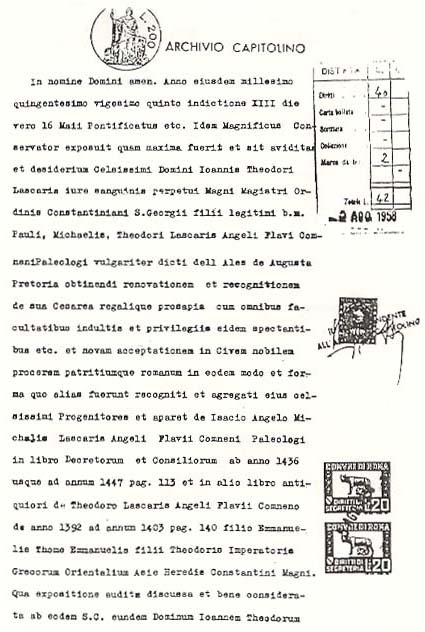
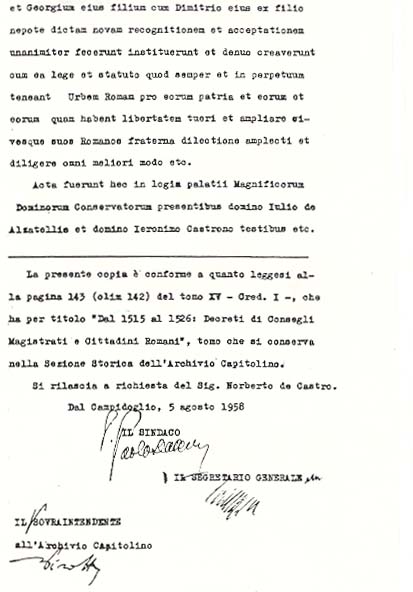
for
Information on origin and vision
of New Byzantium

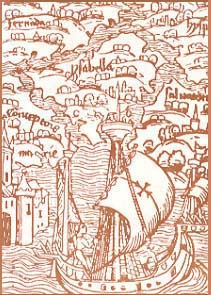
By: Teodoro Lascaris Comneno (1993)
[Head of the House of Lascaris Comnenus of
Constantinople (d. Sep. 20, 2006)]
[*Jaspers,
Karl.
The Origin and Goal of History.
Michael Bullock (Trans.). New Haven: Yale University Press, and London:
Routledge and Kegan Paul, 1953. Greenwood Publishing Group, 1976.]
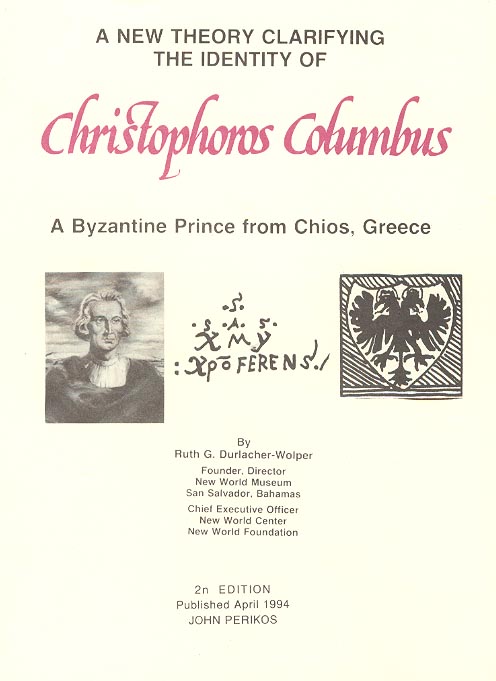
From the rare redlands of gum mastic in Chios (Terra Rubra)
(Christophoros
Columbus: no doubt, a spiritual person of destiny.)
— Read the book —
[courtesy announcement]
¤ ¤ ¤ ¤
Is AMERICA
5th
Century Byzantine Church in Connecticut!
[Ed. It is logical to support the
position that further investigation is necessary. All
possible historical references and in particular a serious archeological
study must be brought to bear: insofar as the subject has a universal
relevance in the context of world history. Most remarkable is mention of the linguistic inscriptions
hewn in the rocks. Such carvings provide indisputable evidence of
yet an earlier settlement in America by people of more advanced standing
at the time—as long, of course, as the finding is confirmed by honest and
proven scientific dating. On the other hand, and using a rather speculative
approach, it is not difficult to consider that Christopher Columbus
(he
usually signed in Greek as,
Χριστόφορος)
acted in keeping with his culture as a
Byzantine prince (see
previous article). It is likely
he kept close relations with the Byzantine Church and the monastic
community, which would have given him intimate knowledge of their
chronicles. Therefore, armed with this significant information, he
presented himself to the Spanish Court and pressed hard for the realization of his project—albeit
thinking that it was India he would reach.]
¤ ¤ ¤ ¤ The following historical account
was tendered by the California Highway
& Transportation District in
a former Internet reference: "Actually, the term Golden Gate refers to the Golden Gate
Strait which is the entrance to the San Francisco Bay from the Pacific Ocean. The
strait is approximately three miles-long by one-mile wide with currents ranging from 4.5
to 7.5 knots. It is generally accepted that the strait was named Chrysopylae or
Golden Gate by Army Captain John C. Fremont, circa 1846. It is said it
reminded him of a harbor in Istanbul or Constantinople named Chrysoceras or Golden
Horn."
(See: www.goldengate.org/).
[NOTE: Despite the
general belief worldwide that the word, Istanbul, is Turkish, the reader would
be well informed to know that in fact the word is Greek Similar to the
custom of residents of San Francisco and of New York who refer to their large urban areas as "the
City," the Byzantines did exactly the same. Not only do San Franciscans call it
"the City," they also constantly call South San Francisco [their southern
industrial neighbor], simply, "South City." City-bound suburbanite New Yorkers or San Franciscans, when asked where are they going,
more likely will respond: "to the City." These are the exact same
words a Byzantine would utter in Greek when responding to the same question. Namely,
"ees-teen Pohleen" or "to the Polis"
(that is, to Constantinople). The refined elegance and euphony of the Greek enunciation deteriorated under the brusqueness of the language of the substitute occupants
of Constantinople and became what we hear today, the grotesque "is-tan-bool."]
It appears much more than casual that Captain John C.
Fremont might have named the entrance to San Francisco Bay, the Golden Gate. The
chief entrance to the City at the great Walls of Constantinople was in fact named the
"Golden Gate." ________ Rome, located on "Seven Hills" [Aventine, Caelian,
Capitoline, Esquiline, Palatine, Quirinal, Viminal] east of the Tiber, was
followed by Constantinople which was also built on seven hills (330 A.D.). Constantinople is situated at the tip of a peninsula surrounded by
the waters of the Bosporus and its harbor, the Golden Horn. San Francisco too is
located at the tip of a peninsula and is surrounded by water three ways - on
the west by the Pacific Ocean, on the east by the San Francisco Bay, and on the
north by the Golden Gate. The interesting detail is that the United States
Geological Survey, 1973a, 1973b describes San Francisco by approximately a seven
mile by seven mile square. The University of California
San Francisco (UCSF) tells us that this is a city of 49 square miles [7 by
7] situated upon 44 hills. Given the famous hilly topography of the
city, one might wonder if there are not five more underestimated elevations that have been
disregarded. This, certainly would round things off to an entertaining
total of 49 (. . . reminiscent of the "1849 Gold Rush" and its highly popular
"San Francisco 49ers"). (See:
http://www.sfsu.edu/~puboff/tour/seven.htm.) The Church of Byzantium or Constantinople is by tradition
the Church of the Apostle Andrew or Andreas in the Greek language. A major
geological feature that marks the San Francisco Bay Area is the famous San Andreas Fault.
In addition to the subject of names, however, the earthquake faults mentioned in
the next section reveal an even more dramatic physical linkage between Constantinople and
San Francisco (Apostolic Universal Center, Christ Unto
Byzantium (Miami: CSA Press for the publishers, 1971), p. 12). ______________ "Quake Provides Lessons About Fault ". . . Scientists say they have learned key lessons from the
deadly earthquake in Turkey that could save lives along the country's North Anatolian
fault and its California twin, the San Andreas. ". . . It jumped over lakes and ignited other faults,
which has some seismologists worried the same could happen along the San Andreas.
". . . Turkey's quake and the 500-mile fault are important to
seismologists who study the San Andreas, which is nearly identical in length and type.
Both also run along
two tectonic plates grinding against each other."
¤ ¤ ¤ ¤
GOLDEN
GATE
Of further interest to our readers may be the following observations:
Similarity
SAN FRANCISCO ~ CONSTANTINOPLE
__________
(about a ninety mile drive north of San Francisco on Coast Highway 1)
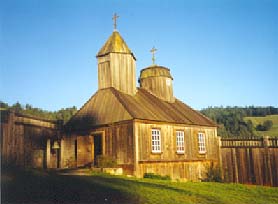
The Chapel at Fort Ross
Despite recurring incidents of destruction and reconstruction, the building today stands in very close resemblance to the original structure of sawed redwood. It is one of the most visited historical sites in the State of California. The devout Russian Orthodox congregation of San Francisco honors the sanctity of the Chapel by holding liturgical services on occasions of sacred significance.
______________
It is difficult to find a substitute for the dramatic ride on California's Coast Highway 1. The grandeur of the Pacific Ocean coupled with the varied ruggedness of the coastal terrain and the briskness of the weather--good or bad--renders one with awe and with a sense of joy for having experienced it.
Some ninety miles north of San Francisco, between the water's edge and right next to the highway, one brushes by the Chapel of Fort Ross where the Russian Orthodox monks had ministered to the faithful. The Chapel was destroyed and rebuilt to its present state. A small number of Russians with the help of a larger group of native Alaskans built the Fort on a land that for centuries was occupied by California Kashaya natives. The Russian colony was dedicated formally on August 13, 1812 and the Fort was abandoned by the Russians in 1841. In their article, The Chapel at Fort Ross: Its History and Reconstruction (in California History: The Magazine of the California Historical Society, LXI:2, 1, Spring 1982), the authors, Diane Spencer-Hancock and William E. Pritchard, inform the reader that: At Fort Ross, we know a special religious service was held upon completion of the stockade in 1812--suggesting the general importance of religion in the everyday lives of the citizens of Ross.
Fort Ross was a settlement of a Russian-American Company. The quest for trade and material wealth was the same for the Russians as it was for the more southern colonizers of the New World. Religious fervor to expand, however, was not amiss as a factor in reaching out for greater things: The Russian monks had long before established missionary activity in Sitka and Kodiak, Alaska, which they continued to bring southward to Fort Ross. The latter, however, was not achieved through a religious structural discipline as was notable in the Latin sector: typical of Orthodox Christianity whose authority of conscience overrides organizational discipline and defines the Faith and thus the Church. The depth of religious conviction that was inculcated in the members of the colony by the Russian clergy far outweighed the lack of a systematic and permanent presence of the clergy at Ross, although it was much needed. Authors Spencer-Hancock and Pritchard explain that: On a spiritual level, there are numerous indications that religion in general played an accepted, integral role in the lives of the colonists of Fort Ross. Indeed, one accepted fact of Russian colonization in North America was the concurrent construction of churches with the trading establishments of the Russian American Company.
For the Greek and the Latin Churches, the delineation had at last been established as to their maximum outreach in the New World . A reference to this is found in an informative brochure on Fort Ross published by the State of California: In 1812 San Francisco Bay marked the northern limit of Spanish settlement . . . . It was several months before the civil and military leaders of Spanish California were even aware of the Russian settlement. Again referring to Spencer-Hancock and Pritchard, they state: Fort Ross was the ultimate expression of Russian eastward expansion across Siberia toward the Aleutian Islands and the Alaskan mainland--a movement not unlike America's own westward progress, although preceding it by a century.
Evidence of a living interest in Fort Ross with emotional overtones of love and nostalgia still exist in Russia. Officials at the California State Historic Park will tell the visitor that an important event occurred when the great-great grandson of a historic Russian cleric visited Fort Ross. Here is part of what John McKenzie writes in an article of the Coast Observer of Gualala, California (v. 21, no.15, sec. 2, July 14, 1989) under the title, Great-Great Grandson Visits Fort Ross: Russian Monk Follows Ancestor's Footsteps:
On June 17 [1989], a Russian Orthodox monk from the Soviet Union made a very emotional visit to the Chapel at Fort Ross State Historic Park. Father Innocent Veniaminov said a prayer in the very place his great-great grandfather, Ioann Veniaminov, had prayed and preached in 1839.
Father Innocent Veniaminov was on a personal pilgrimage to retrace the steps of his ancestor, who preached to the Aleuts and Indians of Alaska and was canonized in 1977 as St. Innocent of the Orthodox faith . . . .
His home is in Leningrad, originally St. Petersburg, and his stay in the [sic] California included a trip to Mission San Jose, which his predecessor had visited more than 150 years before.
As for the great-great grandfather, McKenzie writes:
St. Innocent was born Ivan Popov in the village of Aginskoe in Irkutsk Province, on the northern coast of Siberia, on August 26, 1797. His name was changed to Ioann Veniaminov in the seminary . . . . In 1836 , Veniaminov sent there [to Fort Ross] for a six-week stay, after which he visited several Catholic [Roman] missions, speaking Latin with the priests in San Rafael, San Jose and Santa Clara . . . .
On April 26, 1990 a letter written by the Department of History of the USSR, Academy of Sciences and the Association of researchers of history of Russian-American relations expresses appreciation for the noble work by the California State Department of Parks and Recreation . . . showing the old ties between the people of America and Russia.
|
|
|
The flag of the Russian-American Company still flies high on the grounds inside Fort Ross. The red, white, and blue colors are enhanced by the Byzantine Imperial symbol of the Bicephalous [Two-Headed] Eagle whose high use was a grant to Russia by Constantinople on account of a marriage arrangement.
____________________
(Source. Part of above information from: Fort Ross State Historic Park, CALIFORNIA STATE PARKS, P.O. Box 942896, Sacramento, CA 94296-0001, 800-777-0369, www.parks.ca.gov)
____________
Meeting of the
Arms of the Cross

The
There is in California at Santa Rosa a Christian retreat founded for the purpose of nurturing relations between Eastern Orthodoxy and Roman Catholicism. The activity at the retreat includes every day liturgical services at the lovely Chapel, and prayers along with study are a constant. Those who have Priesthood and all the Sacraments, including the Holy Eucharist, are welcome to join on location the ministry to which the retreat is committed. This will enrich and advance the work of Christian understanding and peace.
Founder and head of the mission is the Reverend John P. O'Brien, a Roman Catholic Priest, who is owner-editor of the publication, Arms of the Cross. He is assisted in all his work by the dedicated, able, and energetic co-worker, Brother Mark Van Doren, who also is in charge of the production and mailing of the publication.
The following words issued by the retreat summarize the vision, goals, and background of the mission, and also explain the symbolism of the above circular design:
When on
Mount Calvary Christ was on his cross, he stretched his arms to the East and
West, as it were, embracing the whole world, symbolizing that his death was for
the salvation of all men, of whatever race or country. Forty days later
on another mount, he instructed his Apostles, "Go forth into the whole
world, teaching them all I have taught you, and baptizing them in the name of
the Father, and the Son, and the Holy Spirit." This the Apostles and successors, bishops, missionaries did
with courage and zeal.
From Jerusalem some went west to Rome and Spain, crossed the Atlantic to Mexico and up the Pacific coast, establishing the 21 California missions, the last and most northern of which was at Sonoma. Meanwhile others went east and to Greece, Kiev, Moscow, across Siberia and the North Pacific to Alaska and down the coast to Fort Ross. When Christians from these two outposts met, the Arms of the Cross had finally encircled the world. But alas they belonged to different churches, Catholic [Roman, ed. op.] and Orthodox, and it had taken 1800 years.
We bought property half way between these two missions, and on an Indian trail where these pioneer Christians met, built with our own hands an East-West monastic-like study center, naming it, The Meeting of the Arms of the Cross. Here we study and pray for unity, and go out to visit Orthodox, showing them love and respect. Ours is not to effect unity -- that is for popes and patriarchs, councils and synods -- we only promote peace and understanding.
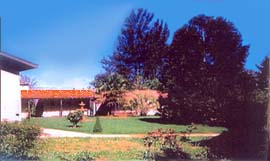
_______________
Father O'Brien writes:
February 13, 2004
Dear Bishop Karras,
Thank you for your continued support. With his visit to Greece, the Pope has broken the ice, and recent reciprocal visits give hope that progress will continue. We appreciate that the Archbishop of Athens and the Patriarch of Constantinople keep after the European Union to include the Christian contribution to Europe in proposed Constitution.
Orthodox do not look kindly on the Holy Roman or the later Austrian Hungarian Empire who were successful, however, in keeping out the Mohammedans. Now, they flood into Europe and even America, and "human rights" demand both that they be given equal treatment and that the Christian development to Europe (and America) not be remembered.
The Greeks of Asia Minor (Turkey), Crete, Thessaly, etc., and even Greece itself know what they are talking about. The suffering they've endured, and loss of souls from the Cross to the Crescent, has been considerable. Moslem numbers are on the increase in the U.S.; and, while many of them are good people, there is a radical arm among them that has been effective in the past and will be again, in snatching Christian souls for Mohammed.
A divided Christianity is a weak one, and it is time for us to think about our survival. If Catholics and Orthodox do not get together in obedience to our Lord to love one another, we will be forced together to assure that our great-grand-children will be Christian, if not for world survival of Christianity. Not Greece nor Rome but Africa is now leading Christian nation, and they are being martyred right and left by Moslems! A black pope is not too far distant! Christian greetings,
(signed) Father O'Brien
_________________________
______________________________________________________________________
Americans
It
is both privilege and duty for all Americans.
Long Island City,
NY, February 2-3, 2002)
IS THE U.S. THE NEW BYZANTIUM?
To the Editor,
As an American of Greek descent, I continue to read the columns and letters which are written in the many publications that address the subject of "Hellenism" and the discourse which ensues over its future and those in whose hands its vitality depends.
The perspectives about which the various authors select to discuss are varied, the positions sometimes extreme, but never does one ever finish reading a piece without being reminded that the opinion expressed is true, righteous, and authoritative. Greeks may have lost their kingdoms, but never their conceit.
Yet over the years, the readings leave me perplexed because often the concept of Hellenism is interpreted by different people in different ways so what results is that points of view don't really differ, they just happen to be talking about different things with the same name. It's very confusing.
I always thought the origins of Hellenism were rooted in the pre-Christian era, where the concepts of freedom, democracy and paganism walked hand-in-hand enriching the lives of its members and justifying the conquests of imperialistic appetites. Then the Romans came to town, changed the names of the streets, but still sent their kids to those schools which taught the wisdom of the Greeks. Soon enough, Romans left Rome itself, and decided to build in the suburbs when Constantine took his new Christian way of life to a place that would not be polluted by the cynicism of the downtown club. So now the literati spoke less of the mind and more of the spirit, and the cross became the interior design rage.
But this Christian era spread throughout the Mediterranean world and beyond, so the parables of Christ were then taught in French, Russian, and even in Arabic dialects. In the meantime, the Constantinople that was Roman then Greek became a vassal of the moors. So the Eastern culture went underground and prayed for redemption which finally came a half a millennium later when the world decided that it was okay for Greece to exist again. So now there is a country which everyday makes its daily crawl out of an existence that not too long ago could be considered third world.
So now, what is Hellenism? What we hear is that when we go to church, the liturgy must be spoken in Greek as if otherwise it's less holy, that we who are Americans of Greek descent are no more than step-children to those who are native to Greece, and that we must take direction from the denizens of Attica and the Phanar in matters of culture and religion.
I'm a second generation Greek, and I lack fluency in Greek, especially the medieval kind. Yeah, it may all sound melodic in Church, but then it only makes sense since it was fashioned to conform to the sounds of the language. The Greek-only argument is not about what is sacred or pure, it is about power.
There is a new center of power, and we not only serve halvah, but lasagna, corned beef and sushi. The US represents the new dynamic of learning and culture to which others conform, including our music, our culture and yes, our language. The Church has two choices: either participate in change, or be rendered obsolete.
We are the new Byzantium. It's time we started calling the shots.
Dean J. Trantalis, Esq.
MEGALOMARTYR

|
Expansion of Western Civilization: from Constantine the Great to Constantinople and Byzantium and onward to America |
NEW BYZANTIUM
is The AMERICAS